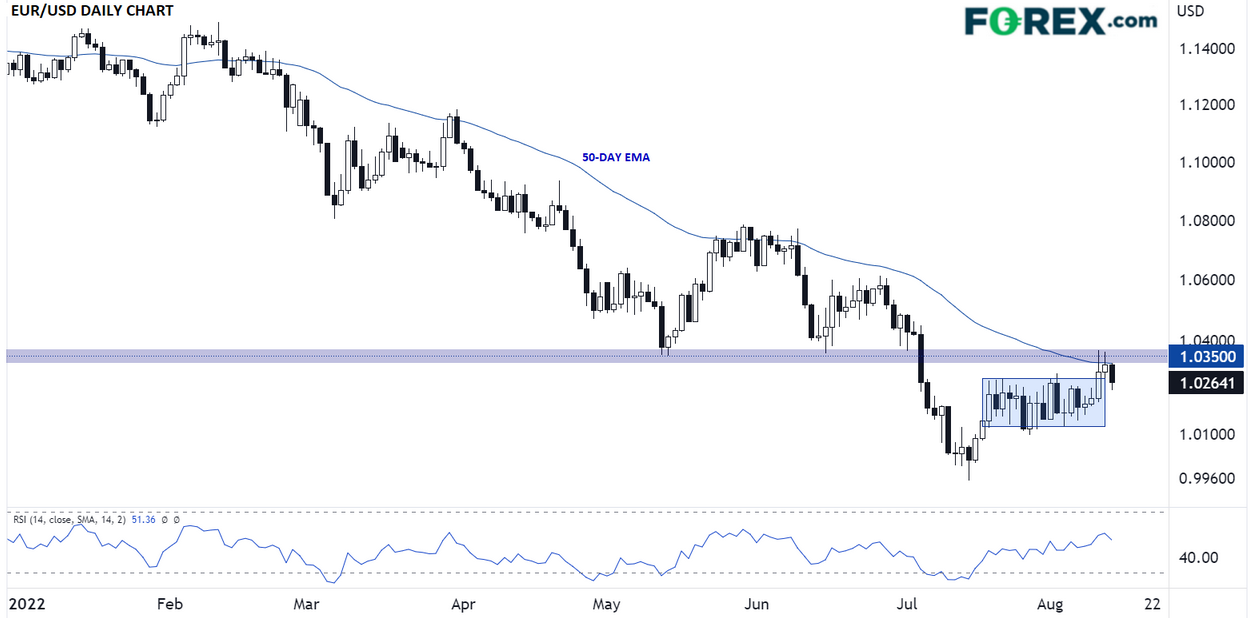Initially tabbed as the start of the “Dog Days of Summer,” featuring low liquidity and relatively little volatility, last week saw an injection of market volatility from softer-than-expected inflation data out of the US. Below, we break down whether it may be a long-awaited sign that we are finally at “peak inflation” as well as what it might mean for Fed policy moving forward. For the coming week, traders will be watching some second-tier data, including a central bank meeting in New Zealand, a jobs report in Australia, and the minutes from the recent FOMC and RBA meetings.
Has the US seen peak inflation?
Following on the back of a stronger-than-expected US jobs report showing elevated wage growth, traders were concerned that the last week’s US inflation reports would not show the expected decline in price pressures. Instead, both the US CPI and PPI reports for July showed that inflation fell by more than expected, and with little in the way of major US economic data until Jerome Powell’s Humphrey-Hawkins testimony at the end of the month, the “peak inflation” narrative may gain more steam this week.
Looking at the market-implied pricing for the next FOMC meeting, traders are pricing in about 60% odds of a 50bps interest rate hike, essentially double the probability that was expected at the start of last week. Not surprisingly, the greenback was the weakest major currency this week as a result. This week’s economic data is unlikely to shift those figures meaningfully, but traders will soon start looking forward to the annual central bank confab at Jackson Hole at the end of the month for more clarity on what the Fed and other central banks are expecting. For now, expect the market to digest last week’s moves, with no major shifts expected this week.
UK GDP recap
Outside of the US dollar, pound sterling was the second-weakest major currency this week, despite a better-than-expected GDP report on Friday. While the UK economy’s -0.6% contraction in June was smaller than anticipated, it still ensured a contraction in Q2. Crucially, this weakness was widespread across consumption, industrial output, services, construction, trade, and government spending, supporting the BOE’s outlook for a rough few quarters to come. Swaps traders are still pricing in an 80%+ chance of another 50bps interest rate hike from the BOE next month.
Earnings to watch
Earnings season is definitely on the downslope, but there will still be a clear theme to this week’s reports: A focus on the retailers and the US consumer. In that vein, traders will get the latest quarterly reports from Walmart (NYSE:WMT) and Home Depot (NYSE:HD) on Tuesday; Lowe’s (NYSE:LOW)), Target (NYSE:TGT), and TJX Companies (NYSE:TJX) on Wednesday; Estee Lauder (NYSE:EL) and Ross Stores (NASDAQ:ROST) on Thursday; and Foot Locker (NYSE:FL) and Buckle (NYSE:BKE) on Friday. Other notable names reporting results include Li Auto (NASDAQ:LI), BHP Group (NYSE:BHP), Cisco Systems (NASDAQ:CSCO), Applied Materials (NASDAQ:AMAT) and Deere (NYSE:DE).
Economic data to watch
As we noted at the top, there are several second-tier economic reports to watch, even as many market participants try to squeeze in their last summer vacations over the next couple of weeks. The FOMC minutes will be closely monitored, though perhaps a bit stale after strong employment and soft inflation in recent weeks. Elsewhere, the RBNZ will make an interest rate decision of its own, Australia will get an update on its labor market, the UK will release a highly-anticipated CPI reading, and a mid-week update on US retail sales will fill in any gaps from retail earnings. See the key economic reports to watch below:
Chart of the Week: EUR/USD

Source: Tradingview, StoneX
The world’s most widely-traded currency pair had probably put some of its traders to sleep after consolidating in about a 150-pip range for the three weeks leading into last week, but the big rally on the back of soft inflation data undoubtedly woke them from their slumbers.
As we look ahead to the coming week’s trade, the biggest question for forex traders will be whether EUR/USD’s bullish breakout above previous resistance at 1.0270 is legitimate. Despite Thursday’s confirmation of softening inflation in the PPI report, EUR/USD bulls were unable to push the pair meaningfully above the long-term previous-support-turned-resistance level at 1.0350, which dates back to the low set at the start of 2017; it also overlaps with the 50-day EMA, a key indicator that has defined the downtrend over the last six months.
Between a bank holiday in some European countries on Monday and a general lack of top-tier European and US data, forex traders may struggle to push the pair above resistance in the mid-1.0300s this week…after all, if major declines in two of the market’s most closely-watched indicators during a period of lower liquidity failed to break it last week, the bullish case is unlikely to be stronger this week! For that reason, we wouldn’t be surprised to see the pair edge lower back into its previous range as the week progresses.
On the other hand, if bulls are able to overcome that resistance level with a confirmed break and close above 1.0350, it would point toward a continuation of the counter-trend rally toward 1.0500 next.
